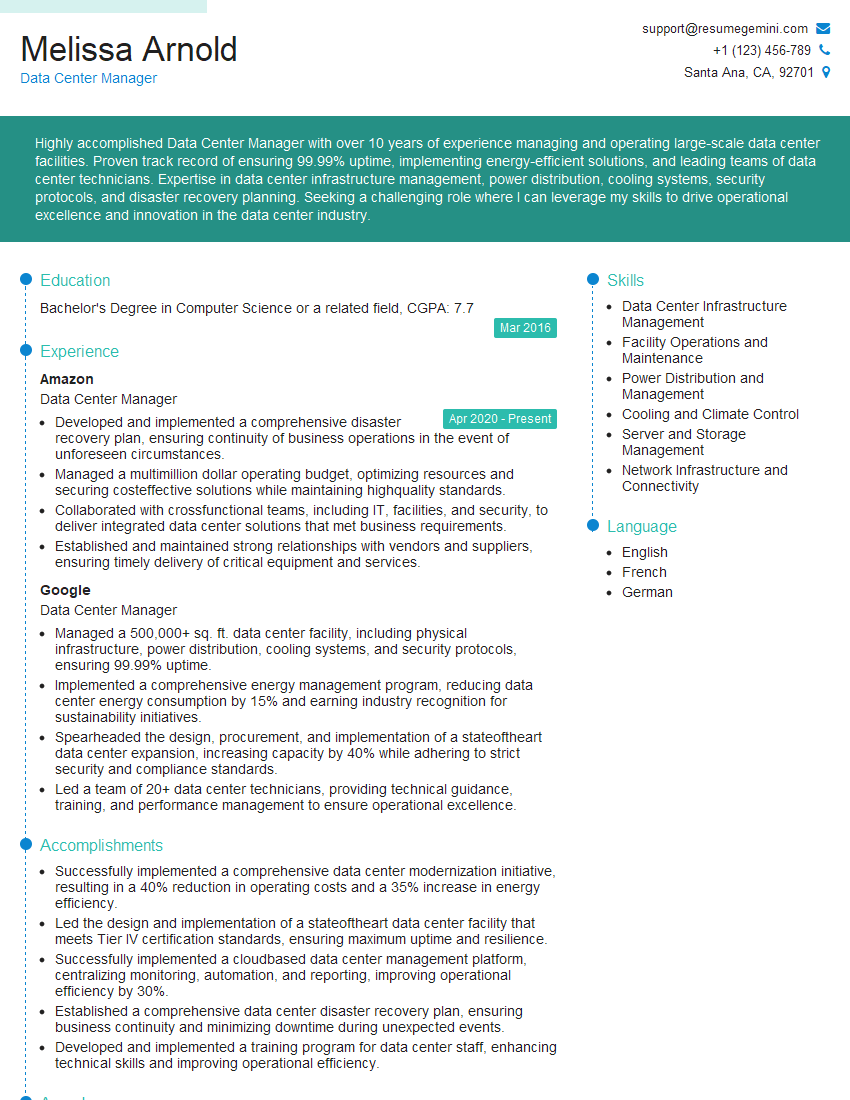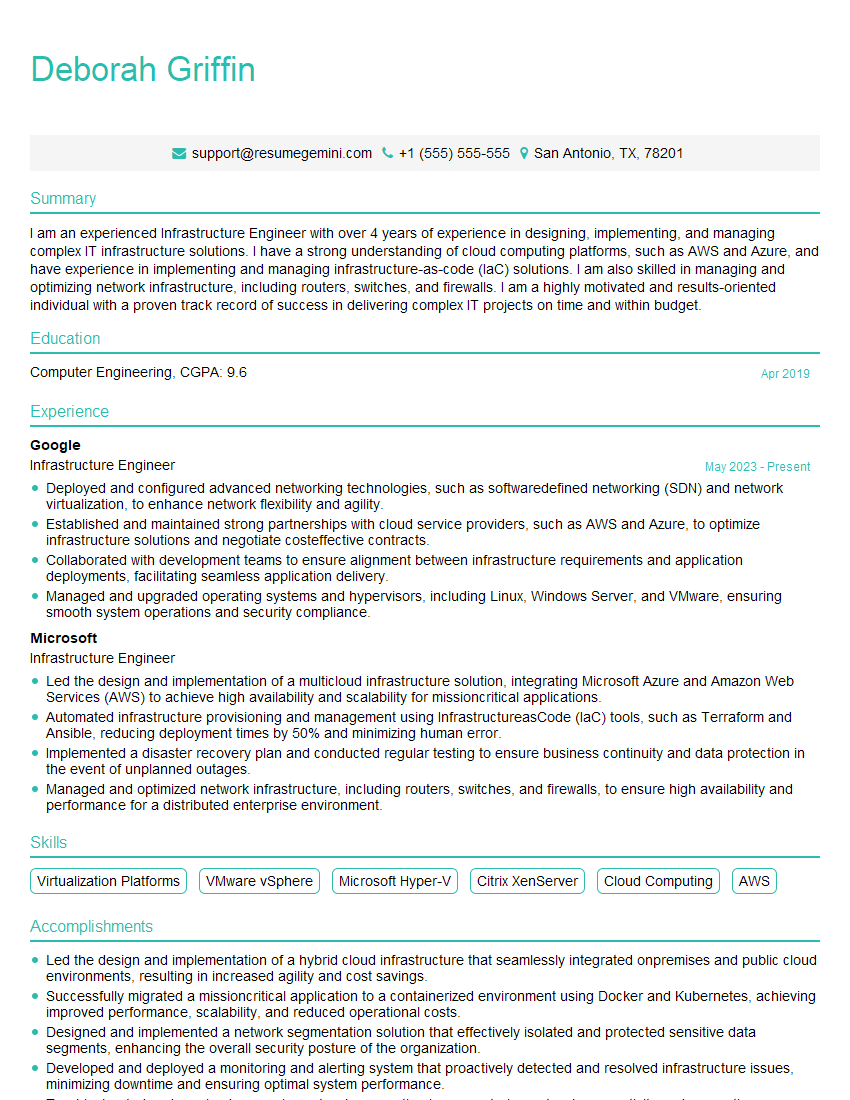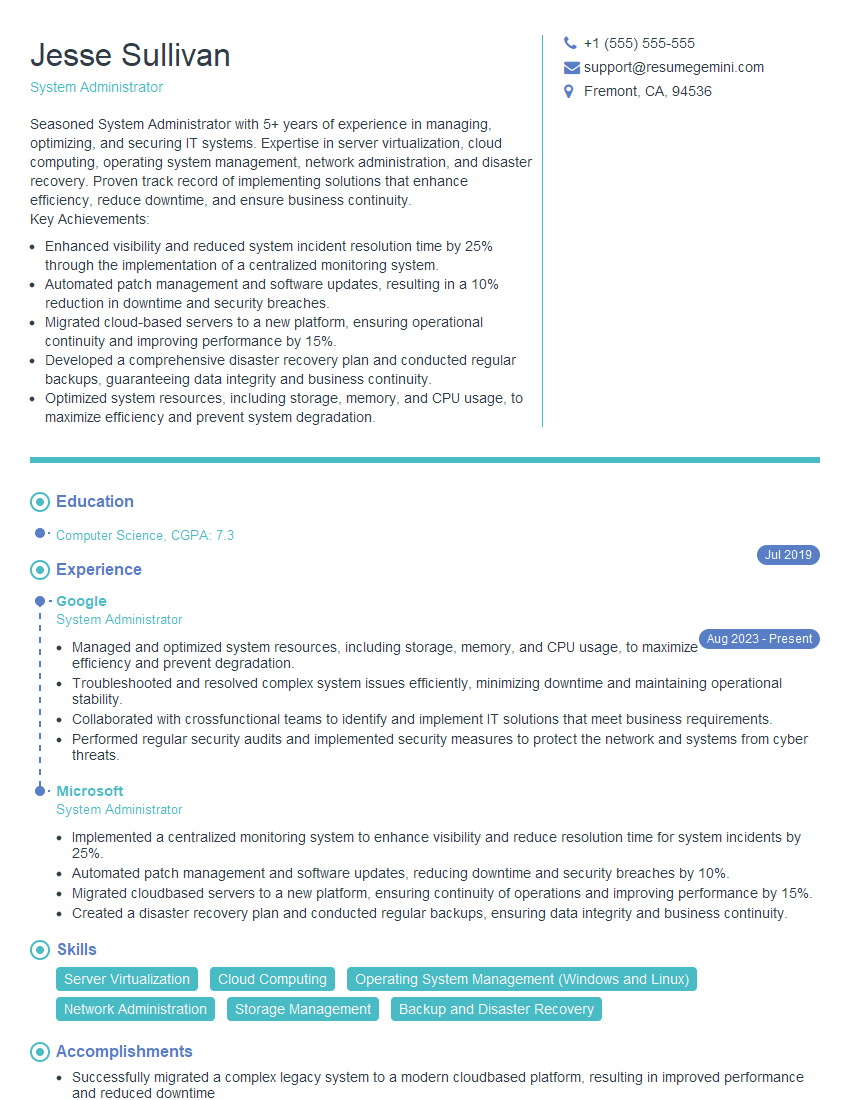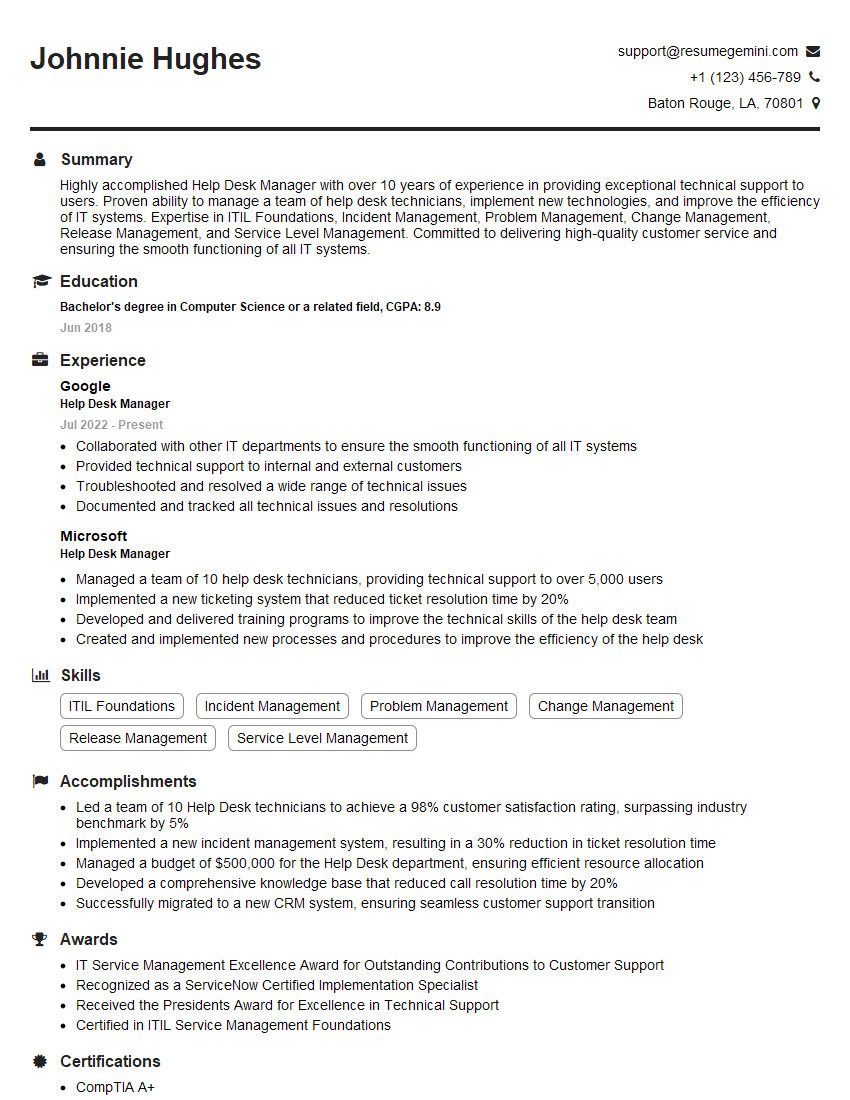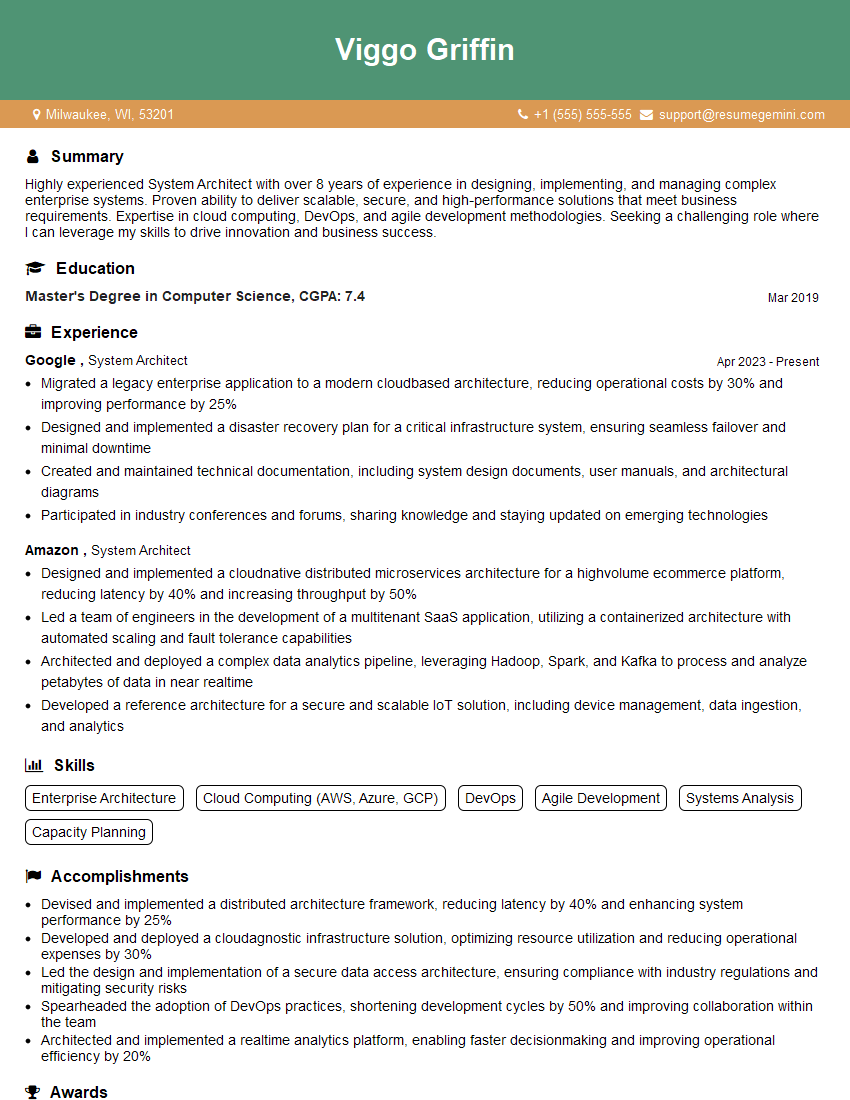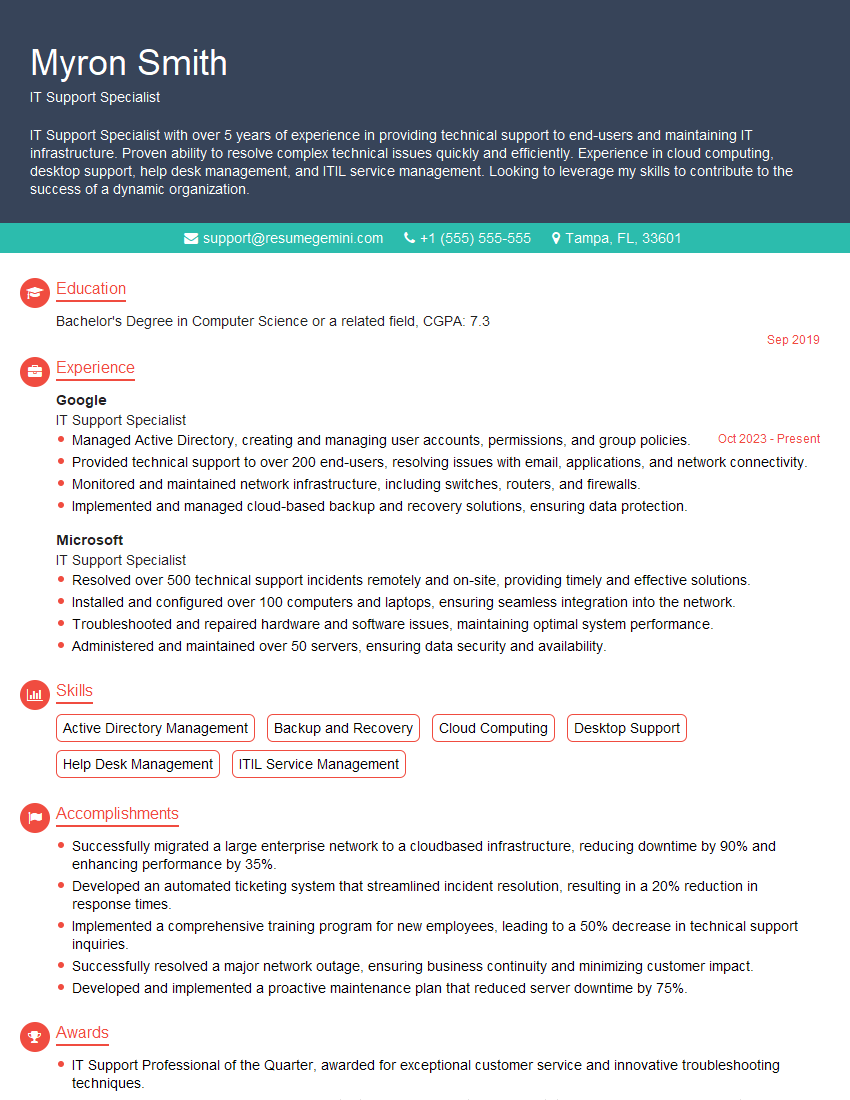Every successful interview starts with knowing what to expect. In this blog, we’ll take you through the top Maintain accurate records of system operations interview questions, breaking them down with expert tips to help you deliver impactful answers. Step into your next interview fully prepared and ready to succeed.
Questions Asked in Maintain accurate records of system operations Interview
Q 1. Explain your experience with different log management systems.
My experience with log management systems spans several platforms, each with its strengths and weaknesses. I’ve worked extensively with centralized logging solutions like Splunk and ELK Stack (Elasticsearch, Logstash, Kibana), which are powerful for aggregating and analyzing logs from diverse sources. Splunk’s interface excels for its intuitive search and visualization capabilities, making it ideal for troubleshooting complex issues and identifying trends. The ELK Stack, on the other hand, offers a more customizable and open-source approach, providing flexibility for tailoring the system to specific needs. I’ve also used more basic syslog solutions for smaller systems where the overhead of a centralized solution wasn’t justified. In one project, migrating from a simple syslog setup to Splunk drastically improved our ability to proactively identify and address performance bottlenecks. The key difference wasn’t just the technology, but the shift in our approach to log analysis—from reactive troubleshooting to proactive monitoring.
For example, using Splunk’s alerting capabilities, we set up notifications for critical errors, enabling us to address issues in near real-time, minimizing downtime and improving system stability. With the ELK Stack, we created custom dashboards to visualize key performance indicators (KPIs), giving us a clear overview of system health and identifying potential areas of improvement.
Q 2. Describe your process for documenting system configurations.
My process for documenting system configurations emphasizes clarity, consistency, and version control. I typically use a combination of methods tailored to the specific system and its complexity. For simple systems, a well-structured text document (e.g., Markdown or plain text) may suffice. For more complex systems, I prefer using configuration management tools like Ansible or Puppet, which allow for version control and automated deployment. These tools provide a central repository for configurations, enabling easy rollback and simplifying updates. Regardless of the tool, I ensure the documentation includes crucial information such as:
- System overview: A high-level description of the system’s purpose and architecture.
- Component details: Specifics about each component, including hardware and software versions.
- Configuration parameters: Detailed settings for each component, ideally with explanations of their function.
- Network diagrams: Visual representations of network connections.
- Dependency diagrams: Illustrating interdependencies between various system components.
This structured approach ensures that the documentation is easy to understand, maintain, and use for troubleshooting or future upgrades. For instance, in a recent project involving a complex web application, using Ansible’s playbooks not only streamlined the configuration process but also created an auditable record of all changes. This was instrumental in resolving an issue where a misconfiguration was identified and quickly reverted.
Q 3. How do you ensure data integrity in system operational records?
Ensuring data integrity in system operational records requires a multi-faceted approach. First, I utilize systems that employ strong data validation and error-checking mechanisms. For instance, checksums can be used to verify data integrity during transfer and storage. Secondly, I implement regular backups of system logs and configuration data. This ensures that data is recoverable in case of corruption or loss. I typically use a 3-2-1 backup strategy (three copies, two different media, one offsite). Thirdly, data is stored in secure locations with access control limitations to prevent unauthorized modification or deletion. Finally, regular audits of the data are conducted to verify its accuracy and completeness. This might involve comparing log entries against known events or cross-referencing data from multiple sources. Think of it like meticulously maintaining a financial ledger—double-checking entries, regular reconciliation, and securely storing the records are all crucial for ensuring accuracy and reliability.
Q 4. What methods do you use to maintain audit trails for system changes?
Maintaining audit trails for system changes is paramount for security and accountability. I leverage several methods to achieve this. Firstly, most operating systems and applications provide built-in logging mechanisms. These logs record changes made to the system, such as user logins, file modifications, and configuration updates. Secondly, I incorporate version control systems (like Git) for configuration files and scripts. This allows me to track all changes made to these files, including who made the changes, when they were made, and what the changes were. Thirdly, I use configuration management tools (such as Ansible or Puppet) that offer built-in auditing features, providing detailed records of all changes implemented through these systems. Lastly, implementing a robust change management process that includes approvals and reviews ensures that all changes are documented properly, and unauthorized changes are prevented. For example, by combining Git and Ansible, I can track every configuration change, including the ability to quickly revert to previous versions if necessary. This ensures not only an auditable trail but also improved system stability and quicker recovery from mistakes.
Q 5. How do you handle conflicting or incomplete system operational data?
Handling conflicting or incomplete system operational data requires a methodical approach. The first step is identifying the source of the conflict or incompleteness. This often involves careful examination of the data itself and reviewing related documentation. Once the source is identified, I then investigate the validity of the data. This might involve comparing the data against other sources, checking timestamps, and looking for patterns or anomalies. I often use data analysis tools to identify inconsistencies and potential errors. For example, I might use SQL queries to identify duplicate or conflicting entries in a database. Once the validity of the data is determined, the appropriate action is taken. This might involve correcting the data, deleting the conflicting entries, or flagging the incomplete data for further investigation. Documenting the process of conflict resolution is vital, ensuring future reference and preventing similar issues. A clear record will assist in tracking and troubleshooting potential future discrepancies. In essence, it’s like being a detective, piecing together clues from different sources to uncover the truth and maintain the integrity of the record.
Q 6. Explain your experience with version control systems for operational documentation.
My experience with version control systems for operational documentation is extensive, primarily using Git. Git allows me to track every change made to the documentation, providing a complete history of revisions. This is crucial for collaboration, rollback capabilities, and auditing purposes. Furthermore, the branching and merging functionalities of Git enable parallel development and easier integration of changes. I typically store operational documentation in a Git repository, creating separate branches for different features or updates. This allows for independent development without affecting the main documentation branch. When changes are ready, they are merged into the main branch, ensuring a cohesive and up-to-date document. For example, during a recent system upgrade, we utilized Git branches to test and validate new documentation alongside the software changes. This prevented deployment delays and minimized the risk of inaccurate or incomplete documentation. This also enabled us to easily revert to the previous documentation version if necessary.
Q 7. How do you prioritize the documentation of different system components?
Prioritizing the documentation of different system components depends heavily on factors such as criticality, complexity, and risk. I typically employ a risk-based approach. Components that are critical to the system’s functionality and have high potential for failure or security vulnerabilities are given higher priority. Similarly, complex components that require detailed understanding for troubleshooting or maintenance are also prioritized. A simple matrix can be used to help visualize the priorities: criticality, complexity, and frequency of change. Components with higher scores across these metrics get higher priority. For example, a database server would receive higher priority than a less critical peripheral device. The documentation should also account for components with a higher frequency of change and those that are heavily reliant upon external systems or third-party integrations. A well-defined prioritization strategy ensures that the most crucial information is readily available, minimizing downtime and improving overall system resilience.
Q 8. Describe a time you identified and corrected an error in system operational records.
During a recent project involving a new server deployment, I noticed a discrepancy in the system logs. The logs indicated successful deployment for all servers, but our monitoring tools showed one server was offline. This inconsistency could have led to inaccurate reporting and potentially missed critical issues.
My investigation revealed a human error: the deployment script had failed silently for one server due to a misconfigured network setting. The script, however, still logged a ‘success’ message due to a flaw in its error handling. I corrected the error in the deployment script to properly report failures and added more robust error checking. I also updated the operational records to reflect the true state of the deployment, including the initial error and the corrective actions taken. This ensured the accuracy of our historical data and prevented future misinterpretations.
This experience highlighted the importance of verifying log data from multiple sources and implementing comprehensive error handling in automated processes.
Q 9. What are the key performance indicators (KPIs) you monitor for system operation record accuracy?
Several KPIs are crucial for monitoring system operational record accuracy. These include:
- Data Completeness: Percentage of logs containing all required fields. A low percentage indicates missing information and potential inaccuracies. For example, if we are tracking security events, we want to ensure that all relevant details, such as timestamps, user IDs, and event types, are present.
- Data Accuracy: Percentage of logs that are verified as correct against independent sources. We use automated checks and manual spot-checks to identify inconsistencies. For instance, comparing logs from the application server with database transaction logs to ensure all transactions are accurately recorded.
- Data Consistency: Measuring the uniformity and reliability of data across different data sources. Inconsistencies can point to errors in data collection or processing. This might involve comparing data from different log files or systems to ensure they align.
- Timeliness: Measuring the delay between an event occurring and its logging. Long delays hinder timely troubleshooting and reporting. Real-time or near real-time logging is often the goal.
- Error Rate: Number of detected errors relative to the total number of records. This helps to pinpoint potential problems in data ingestion or processing. A spike in the error rate can signal problems requiring immediate attention.
Regularly monitoring these KPIs enables proactive identification and resolution of issues impacting record accuracy.
Q 10. How do you ensure compliance with regulations regarding system operational records?
Ensuring compliance involves adhering to all applicable regulations, including industry-specific standards like HIPAA for healthcare data, PCI DSS for payment card data, and GDPR for EU resident data. My approach is multi-faceted:
- Data Retention Policies: We have clearly defined policies specifying how long different types of operational data must be retained. These policies comply with legal and regulatory requirements.
- Access Control: Strict access control measures, including role-based access, multi-factor authentication, and audit trails, ensure only authorized personnel can access sensitive operational records. We use granular permissions to ensure the principle of least privilege.
- Data Encryption: Sensitive data is encrypted both in transit and at rest to protect it from unauthorized access. This is especially crucial for logs containing personally identifiable information (PII) or financial data.
- Regular Audits: We conduct regular internal audits and undergo external audits to verify our compliance with these regulations. These audits assess our processes, policies, and technology controls.
- Data Sanitization: Before any data is archived or deleted, we sanitize or anonymize sensitive information to ensure compliance with privacy regulations.
Proactive compliance is paramount. We continuously update our processes and technologies to reflect the evolving regulatory landscape.
Q 11. How do you handle sensitive data within system operational records?
Handling sensitive data requires a layered approach focusing on confidentiality, integrity, and availability:
- Data Masking and Anonymization: Sensitive data is masked or anonymized whenever possible to reduce the risk of exposure without compromising the integrity of operational insights. This might involve replacing sensitive fields like credit card numbers with placeholders.
- Access Control Lists (ACLs): Strict ACLs limit access to sensitive data only to those with a legitimate need to know. Regular review of ACLs ensures that permissions remain appropriate.
- Data Encryption: Both data at rest (stored on disk) and data in transit (being transmitted over the network) are encrypted using strong encryption algorithms.
- Secure Storage: System operational records are stored in secure locations, preferably with separate physical and logical security measures such as firewalls, intrusion detection systems and physical security.
- Regular Security Assessments: We conduct regular vulnerability assessments and penetration testing to identify and remediate security weaknesses.
Our goal is to balance the need for data analysis with the imperative of protecting sensitive information.
Q 12. What tools and technologies do you use for system operational record management?
We utilize a combination of tools and technologies to manage system operational records effectively:
- Centralized Logging Systems (e.g., ELK Stack, Splunk): These systems aggregate logs from various sources, providing a single pane of glass for monitoring and analysis.
Example configuration for logstash filter: filter { if [type] == "syslog" { grok { match => { "message" => "%{TIMESTAMP_ISO8601:timestamp} %{HOSTNAME:host} %{DATA:message}" } } } } - Database Systems (e.g., PostgreSQL, MySQL): Structured data extracted from logs is stored in databases for efficient querying and reporting. We leverage database features like indexing and partitioning to optimize performance.
- Monitoring and Alerting Tools (e.g., Prometheus, Grafana): These tools enable real-time monitoring of system performance and automatic alerts based on predefined thresholds. This allows rapid identification of performance issues which can affect system logs.
- Version Control Systems (e.g., Git): We use Git to manage and track changes made to the scripts and configurations responsible for data collection and processing.
- Security Information and Event Management (SIEM) systems: SIEM systems provide centralized security monitoring and incident response capabilities.
The choice of tools depends on specific requirements and the complexity of the IT environment.
Q 13. Explain your experience with reporting on system operational data.
Reporting on system operational data is a critical part of my role. I create various reports to meet different stakeholder needs. These reports help in performance monitoring, capacity planning, security auditing, and troubleshooting. My approach includes:
- Custom Reports: I frequently develop custom reports using SQL queries and data visualization tools to answer specific questions or analyze trends. For instance, I might generate a report showing the average response time of a particular API endpoint over a specific time period.
- Pre-defined Dashboards: I build dashboards that display key metrics and visualizations in real-time, providing an overview of system health and performance. These dashboards provide at-a-glance insights to track system performance over time.
- Automated Reporting: I leverage scheduling tools to automatically generate and distribute reports on a regular basis. This ensures timely communication of critical information.
- Data Visualization: I use tools like Grafana and Tableau to create clear, concise, and visually appealing reports and dashboards, making complex data easy to understand.
Effective reporting requires a deep understanding of the data, the ability to extract relevant insights, and the skill to communicate findings clearly to both technical and non-technical audiences. Data storytelling is key to ensure the reports are impactful.
Q 14. How do you ensure system operational records are readily accessible to authorized personnel?
Readily accessible yet secure access to system operational records is vital. We achieve this through:
- Role-Based Access Control (RBAC): Each user is assigned a role with specific permissions to access only the data relevant to their responsibilities. This limits access to sensitive data and ensures only authorized personnel can view it.
- Centralized Repository: All system operational records are stored in a centralized repository, enabling easy retrieval and reducing data silos. This repository is securely managed and regularly backed up.
- Search Functionality: The repository is equipped with robust search functionality, allowing users to quickly locate specific records using relevant keywords or filters. This ensures the efficient retrieval of the necessary information.
- Intuitive User Interface: The interface is designed to be user-friendly, ensuring that authorized personnel can easily navigate and access the information they need, even without extensive technical expertise.
- Secure Access Mechanisms: Multi-factor authentication (MFA) is enforced to prevent unauthorized access, and all access attempts are logged for auditing purposes. We monitor login attempts and promptly address any suspicious activity.
The balance between accessibility and security is crucial. Our approach minimizes security risks while ensuring authorized personnel have easy access to the data they need to perform their jobs effectively.
Q 15. Describe your process for creating and updating system diagrams and flowcharts.
Creating and updating system diagrams and flowcharts is crucial for clear communication and efficient troubleshooting. My process begins with understanding the system’s architecture and functionality. I utilize tools like Lucidchart or draw.io, choosing the most appropriate diagramming method based on the complexity and purpose. For example, a high-level overview might use a UML class diagram, while detailed process steps would be better represented with a flowchart.
I start with a base diagram or flowchart, meticulously adding components and connections. For updates, I follow a version control system, documenting all changes with clear descriptions. This ensures traceability and allows for easy rollback if needed. For example, if a new module is added, I update the diagram immediately and include a note detailing the functionality and integration points. This approach ensures the diagrams remain accurate, current, and easily understandable by anyone interacting with the system. Regular reviews and feedback sessions help to identify and rectify any inaccuracies or gaps.
Imagine building a house – the blueprints (diagrams) need to be precise and updated as changes are made during construction. Otherwise, the final product may not align with the initial plan.
Career Expert Tips:
- Ace those interviews! Prepare effectively by reviewing the Top 50 Most Common Interview Questions on ResumeGemini.
- Navigate your job search with confidence! Explore a wide range of Career Tips on ResumeGemini. Learn about common challenges and recommendations to overcome them.
- Craft the perfect resume! Master the Art of Resume Writing with ResumeGemini’s guide. Showcase your unique qualifications and achievements effectively.
- Don’t miss out on holiday savings! Build your dream resume with ResumeGemini’s ATS optimized templates.
Q 16. How do you ensure the accuracy and completeness of system operational data during migrations?
Data accuracy during migrations is paramount. My strategy involves a multi-step process emphasizing validation at every stage. I begin with a comprehensive data inventory, identifying all data sources and their characteristics. Then, I develop a detailed migration plan outlining the steps, tools, and validation checks.
Before the actual migration, I perform thorough data cleansing and transformation using scripts or ETL (Extract, Transform, Load) tools. This involves identifying and rectifying inconsistencies, such as duplicate entries or missing values. Post-migration, I conduct rigorous data validation using checksums, record counts, and comparison tools to ensure data integrity. This could involve comparing the source and target databases row by row for critical fields, or running automated scripts to check for any inconsistencies. I document all findings in a detailed report. Finally, I establish a monitoring system to track any anomalies post-migration.
Think of moving house – you meticulously pack, transport, and unpack your belongings, ensuring everything arrives safely and in the same condition. Similar precision is required when migrating data to maintain its integrity and completeness.
Q 17. What strategies do you use to improve the efficiency of system operational record management?
Improving the efficiency of system operational record management requires a systematic approach. I utilize several strategies: First, I implement a robust automated logging system that captures relevant events and stores them in a centralized repository. This system eliminates manual data entry and reduces human errors.
Second, I leverage data analytics tools to identify trends and patterns in operational data. This helps in proactive maintenance and capacity planning. I also utilize data visualization techniques like dashboards to make operational data easily accessible and understandable for all stakeholders. Third, I implement a well-defined retention policy and archive old data efficiently, complying with regulatory requirements. This ensures that valuable data is kept safely and that storage costs are optimized. Finally, I regularly review and update our procedures and tools to refine our management process and ensure it stays efficient and effective.
Imagine running a library – efficient organization and proper cataloging ensures that books are easy to locate, improving overall efficiency. Similarly, organized operational records facilitate quick access and analysis.
Q 18. How do you collaborate with other teams to ensure the accuracy of system operational records?
Collaboration is key to ensuring the accuracy of system operational records. I employ several strategies: First, I establish clear communication channels and regular meetings with relevant teams. This could include DevOps, security, and database administrators.
I ensure consistent terminology and definitions are used across all teams to avoid misunderstandings and misinterpretations. I also facilitate knowledge sharing sessions and training to ensure everyone understands their responsibilities in maintaining data accuracy. When data updates or changes are required, I actively involve the relevant teams in the process to ensure consensus and validity. I utilize collaborative tools like shared documents and wikis to streamline communication and allow for easy access to updated records. I also leverage version control systems for all documentation and data, providing complete audit trails.
Consider a construction project – effective communication between the architect, engineers, and contractors is vital to ensure the building is constructed as planned. The same principle applies to maintaining accurate system operational records.
Q 19. Describe your experience with different data storage solutions for system operational records.
My experience spans several data storage solutions for system operational records. I have worked with relational databases like MySQL and PostgreSQL, which are ideal for structured data requiring complex queries and relationships. I’ve also used NoSQL databases like MongoDB and Cassandra for handling large volumes of unstructured or semi-structured data.
For long-term archival, I have experience with cloud storage solutions like AWS S3 and Azure Blob Storage, offering scalability, cost-effectiveness, and data redundancy. My choice of storage solution depends on factors such as data volume, structure, query patterns, scalability needs, and regulatory compliance requirements. Each solution offers unique advantages and drawbacks, and the best choice depends on the specific needs of the system.
Choosing the right storage solution is like choosing the right tool for a job. A hammer is great for driving nails, but not for turning screws. Similarly, different databases are suitable for different types of data and operational needs.
Q 20. How do you handle the decommissioning of old system operational records?
Decommissioning old system operational records requires careful planning and adherence to a well-defined policy. I begin with a thorough review of the records, identifying those that are no longer needed or required by legal or regulatory obligations.
Next, I ensure that all relevant information is archived appropriately before the decommissioning process begins. This might involve transferring data to long-term storage or creating backups for auditing purposes. I always document the decommissioning process completely, outlining the reasons for removal, the dates, and the individuals involved. This is crucial for compliance and accountability. Finally, I delete the records securely, following industry best practices to prevent data breaches and unauthorized access.
Think of cleaning out an old garage – before throwing things away, you sort through them, keeping valuable items and properly discarding the rest. Decommissioning old records requires a similar methodical approach.
Q 21. How do you prevent data loss in system operational records?
Preventing data loss in system operational records requires a multi-layered approach incorporating proactive measures and reactive strategies. Proactive measures include regularly backing up data to multiple locations, using redundant storage systems, and implementing robust data validation checks. This minimizes the risk of data loss due to hardware failure, software errors, or human error.
Reactive strategies include implementing disaster recovery plans to ensure business continuity in the event of a catastrophic event. This plan should clearly define procedures for data recovery and restoration. Regularly testing the disaster recovery plan ensures its effectiveness. Another crucial measure is educating employees about the importance of data security and best practices. I also regularly review security logs and access controls to identify and address potential vulnerabilities.
Consider protecting valuable photos – you might keep multiple copies, store them in different locations, and use cloud storage for redundancy. Similarly, safeguarding operational records requires a multi-faceted approach to prevent data loss.
Q 22. What are some common challenges in maintaining accurate system operational records?
Maintaining accurate system operational records presents several significant challenges. Think of it like meticulously keeping a detailed diary for a complex machine – it’s crucial but demanding. Common hurdles include:
Data Volume and Velocity: Modern systems generate massive amounts of data at incredible speeds. Manually recording everything is simply impossible. For example, a large e-commerce platform might generate millions of log entries daily.
Data Silos: Information might be scattered across various systems and applications, making a unified view difficult. Imagine having different notebooks for each part of a machine’s operation – it’s hard to get the full picture.
Inconsistent Data Formats: Different tools and systems might use varying data formats, hindering integration and analysis. This is like trying to combine notes written in different languages.
Lack of Standardization: Without established standards for logging and reporting, data quality suffers. This is similar to a team using different measurement units for the same process.
Human Error: Manual data entry introduces the risk of mistakes and inconsistencies. Just like a typo in a critical document, a small error in system logs can have significant consequences.
Data Security and Compliance: Protecting sensitive operational data from unauthorized access and ensuring compliance with regulations (like GDPR or HIPAA) are paramount. This is akin to safeguarding a company’s financial records under strict security protocols.
Q 23. Describe your experience with automating aspects of system operational record management.
I have extensive experience automating system operational record management. In a previous role, we migrated from a primarily manual system to a fully automated one using a combination of scripting, logging frameworks, and centralized log management tools. For example, we used Python scripts to collect logs from various servers and databases, then processed and enriched them using tools like Elasticsearch and Logstash. This allowed us to:
Reduce manual effort: Automation eliminated the need for manual log collection and entry, freeing up personnel for more strategic tasks.
Improve data accuracy: Automated systems minimize human error, ensuring consistent and reliable data.
Enable real-time monitoring: We implemented dashboards to monitor key system metrics in real time, enabling proactive issue identification and resolution.
Enhance security: Centralized log management provided a single point of access for security audits and incident response.
Specifically, we leveraged ELK stack (Elasticsearch, Logstash, Kibana) to create a powerful and scalable log management solution. This involved configuring Logstash to parse logs from diverse sources, storing them in Elasticsearch, and then visualizing them using Kibana’s dashboards.
Q 24. How do you ensure system operational records are easily searchable and retrievable?
Searchability and retrievability of system operational records are crucial. Think of it as having a well-organized library – easy to find the book you need when you need it. We achieve this through:
Structured Data: Using standardized data formats and schemas ensures data consistency and allows for efficient searching and filtering. This is like organizing books by author and genre, not just by color.
Metadata Tagging: Adding rich metadata (timestamps, server names, event types) allows for granular searches. This is like adding keywords and summaries to each book’s entry in a library catalog.
Full-text Search Capabilities: Employing a robust full-text search engine (like Elasticsearch or Solr) enables quick retrieval of information based on keywords and phrases. This is like using the library’s search bar to find books by title or subject.
Database Indexing: Proper database indexing dramatically improves query performance. This is similar to having an efficient library shelving system – you know precisely where to find specific books.
Query Language Support: Providing access through a user-friendly query language (like SQL or Kibana’s query language) empowers users to perform complex searches.
Q 25. What is your experience with using different data formats for system operational records?
My experience encompasses various data formats for system operational records, including:
Text-based formats (log files):
.log,.txt– These are common but require parsing for analysis.JSON (JavaScript Object Notation): A human-readable format, easily parsed by machines, excellent for structured data.
{"timestamp":"2024-10-27T10:00:00","event":"user_login","user_id":123}XML (Extensible Markup Language): A more complex structured format, suitable for hierarchical data.
CSV (Comma-Separated Values): Simple, tabular format, easily imported into spreadsheets or databases.
Databases (SQL, NoSQL): Relational databases (like MySQL, PostgreSQL) and NoSQL databases (like MongoDB, Cassandra) provide powerful storage and retrieval capabilities.
The choice of format depends on the specific application and requirements. For instance, JSON is preferred for its flexibility and machine-readability, while CSV is suitable for simple, tabular data that needs to be easily exported to a spreadsheet.
Q 26. Explain your experience with integrating system operational records with other systems.
Integrating system operational records with other systems is essential for comprehensive monitoring and analysis. This is like connecting different parts of a machine to a central control panel. I’ve integrated system logs with:
Monitoring and alerting systems: Logs are used to trigger alerts for critical events, such as server failures or security breaches.
Business intelligence (BI) tools: Logs provide data for performance analysis, identifying bottlenecks and areas for improvement.
Security information and event management (SIEM) systems: Centralized log management facilitates security auditing and incident response.
Ticketing systems: Automatic ticket generation based on log events streamlines issue resolution.
Integration techniques typically involve APIs, message queues, or database connectors. For example, I’ve used APIs to send log data from a web application to a SIEM system, enabling real-time security monitoring.
Q 27. How do you train others on best practices for maintaining accurate system operational records?
Training others on best practices involves a multi-faceted approach. It’s not just about giving instructions; it’s about building a culture of accurate record-keeping. My approach includes:
Hands-on workshops: Practical sessions demonstrating log management tools and techniques.
Documented procedures: Clear, step-by-step guides on logging procedures and data handling.
Regular review and feedback: Monitoring compliance and providing constructive feedback to ensure adherence to best practices.
Example log entries and analysis: Illustrative cases showing the importance of detailed, accurate logging. Think of it as learning from case studies of successful (and unsuccessful) logging.
Mentorship and ongoing support: Providing ongoing guidance and support to ensure continuous improvement.
The goal is to foster a mindset where accurate record-keeping is viewed not just as a task, but as a crucial component of reliable system operation and efficient troubleshooting.
Key Topics to Learn for Maintain Accurate Records of System Operations Interview
- Data Integrity and Accuracy: Understanding the importance of accurate data entry, validation, and error handling in system logs and operational records. This includes exploring different data formats and their suitability for various system operations.
- Record Keeping Methodologies: Familiarize yourself with different methods for maintaining system operational records, including manual logbooks, automated logging systems, and database management. Consider the advantages and disadvantages of each approach.
- System Monitoring Tools and Techniques: Learn how to utilize system monitoring tools to collect and analyze operational data. This includes understanding key performance indicators (KPIs) and their relevance to system performance and identifying potential issues.
- Data Security and Compliance: Understand the importance of securing operational data to meet regulatory compliance requirements (e.g., HIPAA, GDPR). Explore different security protocols and best practices for data protection.
- Troubleshooting and Problem Solving: Develop your ability to use operational records to diagnose and troubleshoot system issues. Practice interpreting logs and identifying patterns to pinpoint the root cause of problems.
- Reporting and Analysis: Learn how to generate reports from operational data to present key findings and insights to stakeholders. This includes understanding different types of reports and choosing the most appropriate format for different audiences.
- Automation and Scripting (if applicable): Explore how automation and scripting can improve the efficiency and accuracy of record keeping. This might include using tools like Python or PowerShell to automate tasks.
Next Steps
Mastering the art of maintaining accurate system operation records is crucial for career advancement in any technical field. It demonstrates your attention to detail, problem-solving skills, and commitment to maintaining efficient and reliable systems. To significantly boost your job prospects, invest time in creating an ATS-friendly resume that effectively showcases your skills and experience. ResumeGemini is a trusted resource to help you build a professional and impactful resume. We provide examples of resumes tailored to highlight expertise in maintaining accurate records of system operations to help you get started. Let us help you craft a resume that captures the attention of potential employers.
Explore more articles
Users Rating of Our Blogs
Share Your Experience
We value your feedback! Please rate our content and share your thoughts (optional).
What Readers Say About Our Blog
Live Rent Free!
https://bit.ly/LiveRentFREE
Interesting Article, I liked the depth of knowledge you’ve shared.
Helpful, thanks for sharing.
Hi, I represent a social media marketing agency and liked your blog
Hi, I represent an SEO company that specialises in getting you AI citations and higher rankings on Google. I’d like to offer you a 100% free SEO audit for your website. Would you be interested?
